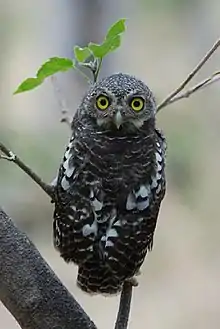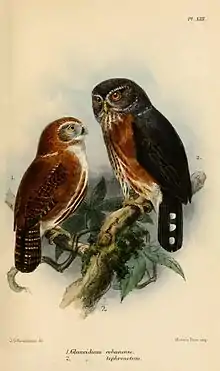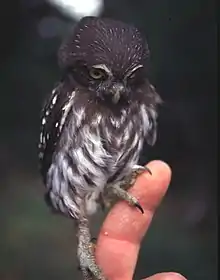Pygmy owl
Pygmy owls are members of the genus Glaucidium. They belong to the typical owl family, Strigidae. The genus consists of 29 species distributed worldwide. These are mostly small owls, and some of the species are called "owlets". Most pygmy owl species are diurnal, meaning they are most active during dawn, dusk, and daytime, and they mainly hunt large insects and other small prey.[1] While primarily prevalent in North American countries—including the United States, Canada, and Mexico—Pygmy owls are considered threatened subspecies under the United States Endangered Species Act.[2] More specifically, these owls can be found lurking in the mountain ranges of western United States territory, including California.[3]
| Pygmy owls Temporal range: Late Pliocene to Recent | |
|---|---|
 | |
| African barred owlet | |
| Scientific classification | |
| Domain: | Eukaryota |
| Kingdom: | Animalia |
| Phylum: | Chordata |
| Clade: | Dinosauria |
| Class: | Aves |
| Order: | Strigiformes |
| Family: | Strigidae |
| Genus: | Glaucidium F. Boie, 1826 |
| Type species | |
| Strix passerina Linnaeus, 1758 | |
| Species | |
|
See text | |


Taxonomy
The genus Glaucidium was introduced in 1826 by the German zoologist Friedrich Boie.[4] The type species was designated as the Eurasian pygmy owl by George Robert Gray in 1840.[5][6] The genus name is from Ancient Greek glaukidion meaning "little owl" or "owlet". It is diminutive of glaux meaning "owl".[7]
A molecular phylogenetic study of the owls published in 2019 found that the widely distributed northern hawk-owl (Surnia ulula) is sister to the genus Glaucidium.[8]
Species
The genus contains 29 living species:[9]
- Eurasian pygmy owl (Glaucidium passerinum)
- Pearl-spotted owlet (Glaucidium perlatum)
- Red-chested owlet (Glaucidium tephronotum)
- Sjöstedt's barred owlet (Glaucidium sjostedti)
- Asian barred owlet (Glaucidium cuculoides)
- Javan owlet (Glaucidium castanopterum)
- Jungle owlet (Glaucidium radiatum)
- Chestnut-backed owlet (Glaucidium castanotum)
- African barred owlet (Glaucidium capense)
- Albertine owlet (Glaucidium albertinum)
- Northern pygmy owl (Glaucidium californicum)
- Mountain pygmy owl (Glaucidium gnoma)
- Baja pygmy owl (Glaucidium hoskinsii)
- Guatemalan pygmy owl (Glaucidium cobanense)
- Costa Rican pygmy owl (Glaucidium costaricanum)
- Cloud-forest pygmy owl (Glaucidium nubicola)
- Andean pygmy owl (Glaucidium jardinii)
- Yungas pygmy owl, (Glaucidium bolivianum)
- Colima pygmy owl, (Glaucidium palmarum)
- Tamaulipas pygmy owl (Glaucidium sanchezi)
- Central American pygmy owl (Glaucidium griseiceps)
- Subtropical pygmy owl (Glaucidium parkeri)
- Amazonian pygmy owl (Glaucidium hardyi)
- East Brazilian pygmy owl (Glaucidium minutissimum)
- Pernambuco pygmy owl (Glaucidium mooreorum)
- Ferruginous pygmy owl (Glaucidium brasilianum)
- Pacific pygmy owl (Glaucidium peruanum)
- Austral pygmy owl (Glaucidium nana)
- Cuban pygmy owl (Glaucidium siju)
Etymology
The etymology of "pygmy" has its roots in the Greek word "πυγμαῖος" (pygmaioi), which means "of the fist," suggesting the small stature of the object, or in this case animal, in question. Correspondingly, the pygmy owl is likened to the length from the elbow to the knuckle when one's fist is clenched. There are parallels to be drawn to the Latin word equivalent, "pygmaei," translating to dwarfish.[10] As demonstrated by the amalgamation of its Greek and Latin roots, the pygmy owl's name is derived from their diminutive size compared to other owl species. The earliest evidence of this term's usage to describe species in the Glaucidium genus dates back to the 1850s, believed to be coined by zoologist Spencer Baird.[11]
Fossil specimens
Kurochkin's pygmy owl (Glaucidium kurochkini) is a fossil species known from the La Brea Tar Pits that likely went extinct during the Quaternary extinction. The supposed prehistoric species "Glaucidium" dickinsoni is now recognized as a burrowing owl, probably a paleosubspecies providentiae. Bones of an indeterminate Glaucidium have been recovered from Late Pliocene deposits in Poland.[12] Fossil material belonging to a new species of Glaucidium was described in 2020 as G. ireneae. The fossils were recovered from Pliocene/Pleistocene transitional strata in South Africa.[13]
Description and characteristics
Amongst the upwards of 200 other owl species, the pygmy owl has several identifying characteristics. While its head is an overall round shape, the sides of its face stretch to the left and right respectively, forming an elliptical shape sideways. Its ears, similar to other owls, are covered by feathers on the side of its face behind the eyes. To better triangulate sounds and make hunting easier, the pygmy owl's ears may be asymmetrically placed.[14] Its eyes are bright yellow, while its beak is a mix of yellow and white. The pygmy owl can be seen with outsized feet and sharp talons as an extension, structurally allowing the animal to be an efficient hunter tackling prey much larger than itself.[15] As suggested by its name and etymology, however, the pygmy owl is roughly 6 to 7 inches in height. Counterintuitive to human nature, the female owls tend to be bigger than males.[16] Relative to its minuscule size, its tail is considered long. Additionally, the tail is one of the pygmy owl's most important identifying characteristics, as it expresses its reaction to threatening situations using its tail: rotating it, moving it up and down, as well as side to side.[16]
Perhaps a crucial, defining characteristic of the pygmy owl are their false eyes at the back of their head, for which the formal term is ocelli.[17] Such markings are intended to mirror the pygmy owl's actual eyes. While the conventional purpose of such markings are to deter potential predators from ambush attacks, the pygmy owl utilizes them for a different purpose: causing confusion to their prey. Smaller birds that comprise the pygmy owl's regular diet have a tendency to resist attempts to consume them. By having false eyes at the back of their head, pygmy owls prevent direct attacks to their face.[18] The physical appearance of the ocelli resemble a white infinity shape, with black oval-shaped feathers filling the negative space in.[17]
The dominant color pattern for the pygmy owl combines dark brown with smaller, white specks scattered around its head and wings. The sides of its body, primarily under the wings, follow a similar outline. While this is true for some regions, the pygmy owl's color vastly depends on its surrounding environment. For instance, the Northern pygmy owl follows this aforementioned brown pattern to better camouflage with its surroundings. However, its belly is composed of longer streaks of white feathers that cut through its dark brown counterparts.[19] The Ferruginous pygmy owl, on the other hand, has more grey and red colors associated with them.[20] However, these characteristics are not universal across all pygmy owls, as their individual patterns can vary significantly depending on their genetic influence.
Habitat
%252C_Eastern_Belgium_(14581626193).jpg.webp)
Pygmy owls can primarily be found in western North America, with regions encompassing Canada, the United States, and Mexico. In line with the diversity of countries, these animals display incredible flexibility in terms of specific habitats by which they reside.[21] The predominant environment they are found in is forests, ranging from temperate and moist to deciduous woods. However, they can also be found in savannas, wetlands, open woodlands, swamps, and meadows.[18] In correspondence with this, their preference for elevation greatly depends on the region they affiliate with. However, the general range of altitudes they prefer are between 3,000 and 6,000 feet above sea level.[22]
The pygmy owl's habitat also depends on availability in their country of residence. In Mexico, they tend to be found in pine-oak and scrub forests, while their Honduras counterparts plant their roots in highland pine and cloud forests.[23] Due to their preferred reproduction method of exploiting tree cavities produced by woodpeckers, this forest environment works to their advantage in terms of conserving their energy finding potential nesting locations.[24]
Human impact and conservation efforts
As an inevitable and at times inadvertent consequence of human development, the pygmy owl's habitat, and by extension the animal itself, is under threat. A broader characterization of human impact on the pygmy owl is climate change, urbanization, agricultural expansion, and more. As a direct result, habitat fragmentation is occurring at an alarming rate—a rate at which the owls cannot adapt to naturally.[2] While the general trajectory of habitat destruction for pygmy owls is that of a declining one, certain regions are experiencing more difficulty than others. For instance, California and Arizona, which typically harbor drier conditions that are exacerbated by climate change, are prime areas that have seen pygmy owl populations decline due to reduced prey and decreased vegetative environments from extreme weather and droughts.[25]
Under the United States Endangered Species Act, the pygmy owl's critical habitat areas are under federal protection, and their recovery plan is being monitored and implemented constantly to foster long term viability.[26] Such rebound plans are happening at the state and local level concurrently. As governments step up their efforts to protect this species from extinction, they are engaging in habitat acquisition to ensure no private activities are harming the pygmy owls.[2] While public campaigns step up to protect this species, the fact of the matter remains that human impact continues to have a colossal influence on the pygmy owls' existence, and their numbers are decreasing at alarming rates.
References
- Heraldo V. Norambuena; Andrés Muñoz-Pedreros (September 2012). "Diurnal Activity of the Austral Pygmy Owl (Glaucidium nana) in Southern Chile". The Wilson Journal of Ornithology. 124 (3): 633–635. doi:10.1676/11-118.1.
- "Cactus Ferruginous Pygmy-Owl Listed". FWS.gov. U.S. Fish & Wildlife Service. 2023-07-06. Retrieved 2023-10-18.
- "Northern Pygmy-Owl Overview, All About Birds, Cornell Lab of Ornithology". www.allaboutbirds.org. Retrieved 2023-10-25.
- Boie, Friedrich (1826). "Generalübersicht der ornithologischen Ordnungen, Familien und Gattungen". Isis von Oken (in German and Latin). 19. cols 969–981 [970].
- Peters, James Lee, ed. (1940). Check-List of Birds of the World. Vol. 4. Cambridge, Massachusetts: Harvard University Press. p. 127.
- Gray, George Robert (1840). A List of the Genera of Birds : with an Indication of the Typical Species of Each Genus. London: R. and J.E. Taylor. p. 6.
- Jobling, James A. (2010). The Helm Dictionary of Scientific Bird Names. London: Christopher Helm. p. 174. ISBN 978-1-4081-2501-4.
- Salter, J.F.; Oliveros, C.H.; Hosner, P.A.; Manthey, J.D.; Robbins, M.B.; Moyle, R.G.; Brumfield, R.T.; Faircloth, B.C. (2019). "Extensive paraphyly in the typical owl family (Strigidae)". The Auk. 137 (ukz070). doi:10.1093/auk/ukz070.
- Gill, Frank; Donsker, David; Rasmussen, Pamela, eds. (January 2021). "Owls". IOC World Bird List Version 11.1. International Ornithologists' Union. Retrieved 24 May 2021.
- "pygmy owl | Search Online Etymology Dictionary". www.etymonline.com. Retrieved 2023-10-25.
- "pygmy owl, n. meanings, etymology and more | Oxford English Dictionary". www.oed.com. Retrieved 2023-10-25.
- Mlíkovský, Jirí (2002). Cenozoic Birds of the World, Part 1: Europe (PDF). Prague: Ninox Press. p. 215. Archived from the original (PDF) on 2007-06-11.
- Pavia, Marco (2020-11-15). "Palaeoenvironmental reconstruction of the Cradle of Humankind during the Plio-Pleistocene transition, inferred from the analysis of fossil birds from Member 2 of the hominin-bearing site of Kromdraai (Gauteng, South Africa)". Quaternary Science Reviews. 248: 106532. doi:10.1016/j.quascirev.2020.106532. ISSN 0277-3791. S2CID 224866137.
- Santillan, Miguel Angel; Sarasola, Jose Hernán; Dolsan, Marcelo (June 2008). "Ear Tufts in Ferruginous Pygmy-Owl (Glaucidium brasilianum) as Alarm response". Journal of Raptor Research. 42 (2): 153–154. doi:10.3356/JRR-06-81.1. ISSN 0892-1016.
- Hansen, David (February 2020). "Skin and Bone: Surface and Substance in Anglo-Colonial Portraiture". British Art Studies. doi:10.17658/issn.2058-5462/issue-15/dhansen.
- "Ferruginous Pygmy-Owl". American Bird Conservancy. Retrieved 2023-10-25.
- "These Birds of Prey Have Eyes in the Backs of Their Heads". www.audubon.org. National Audubon Society. 2019-07-02. Retrieved 2023-10-25.
- "Northern Pygmy Owl". www.peregrinefund.org. The Peregrine Fund. Retrieved 2023-10-25.
- General Technical Report RMRS. The Station. 1998.
- Holt, Denver W. (September 2022). "Why Are Snowy Owls White and Why Have They Evolved Distinct Sexual Color Dimorphism? A Review of Questions and Hypotheses". Journal of Raptor Research. 56 (4): 440–454. doi:10.3356/JRR-21-56. ISSN 0892-1016.
- Strøm, Hallvard. "Home range and habitat selection in the Pygmy Owl Glaucidium passerinum" (PDF).
- Pačenovský, Samuel; Shurulinkov, Peter (January 2008). "Latest data on distribution of the Pygmy Owl (Glaucidium passerinum) in Bulgaria and Slovakia including population density comparison". Raptor Journal. 2 (2008): 91–106. doi:10.2478/v10262-012-0023-5.
- "Northern Pygmy-Owl Life History, All About Birds, Cornell Lab of Ornithology". www.allaboutbirds.org. Retrieved 2023-10-25.
- Baroni, Daniele; Korpimäki, Erkki; Selonen, Vesa; Laaksonen, Toni (2020-03-15). "Tree cavity abundance and beyond: Nesting and food storing sites of the pygmy owl in managed boreal forests". Forest Ecology and Management. 460: 117818. doi:10.1016/j.foreco.2019.117818. ISSN 0378-1127.
- "Federal Register :: Request Access". unblock.federalregister.gov. Retrieved 2023-10-25.
- "The US Endangered Species Act". World Wildlife Fund.
External links
- Pygmy owl information
- Mountain Pygmy Owl
- Mountain Pygmy Owl "eyes in back of head"
- Ferruginous pygmy owl
- Colima pygmy owl
- Eurasian pygmy owl
- "Big fight over tiny owl" - CNN/AP article on pygmy owl's endangered species status in Arizona
- ' Pygmy Owls Archived 2015-07-15 at the Wayback Machine - documentary produced by Oregon Field Guide
- The Neblina Pygmy owl - 2018 BBC internet article on new species found in the Pico da Neblina National Park, Brazil